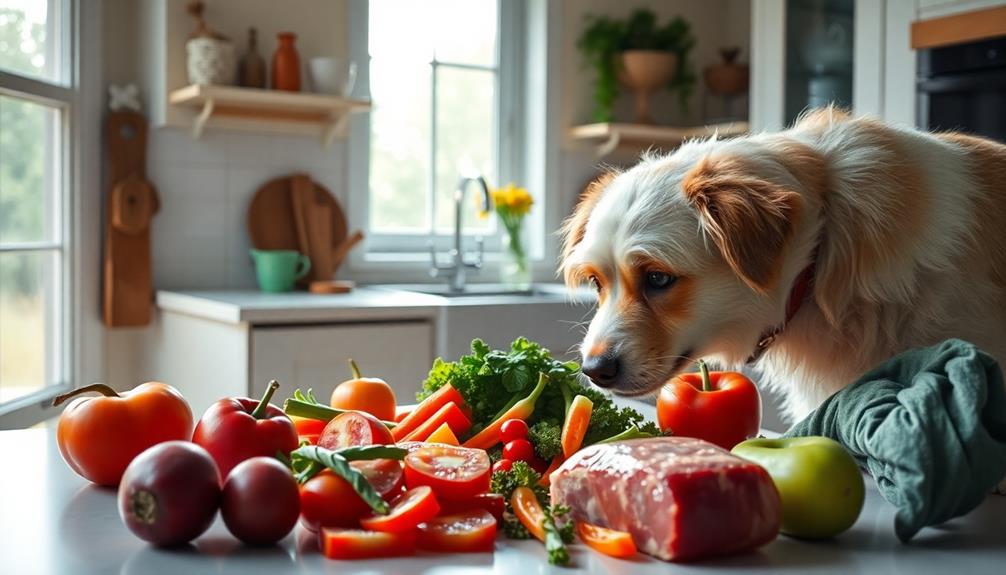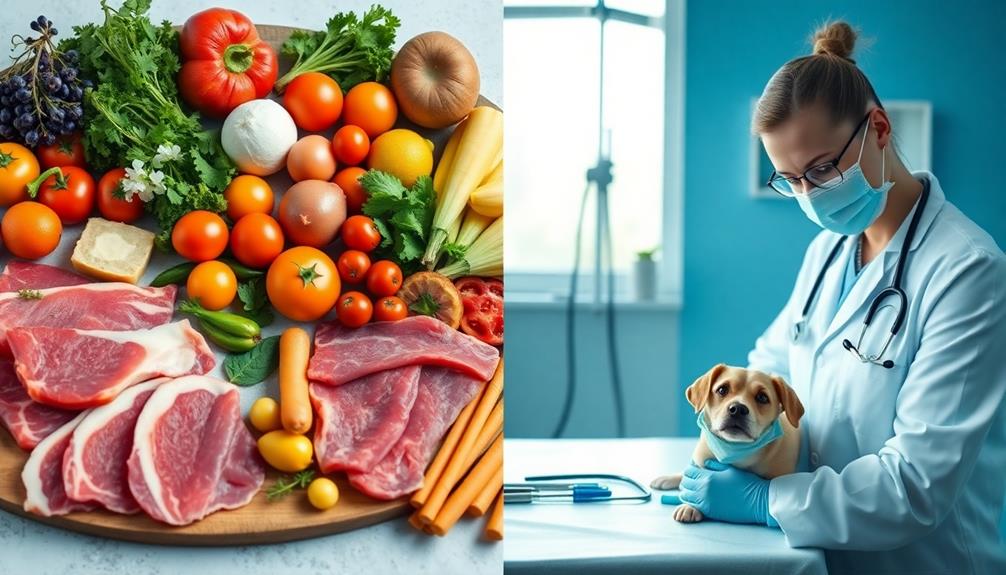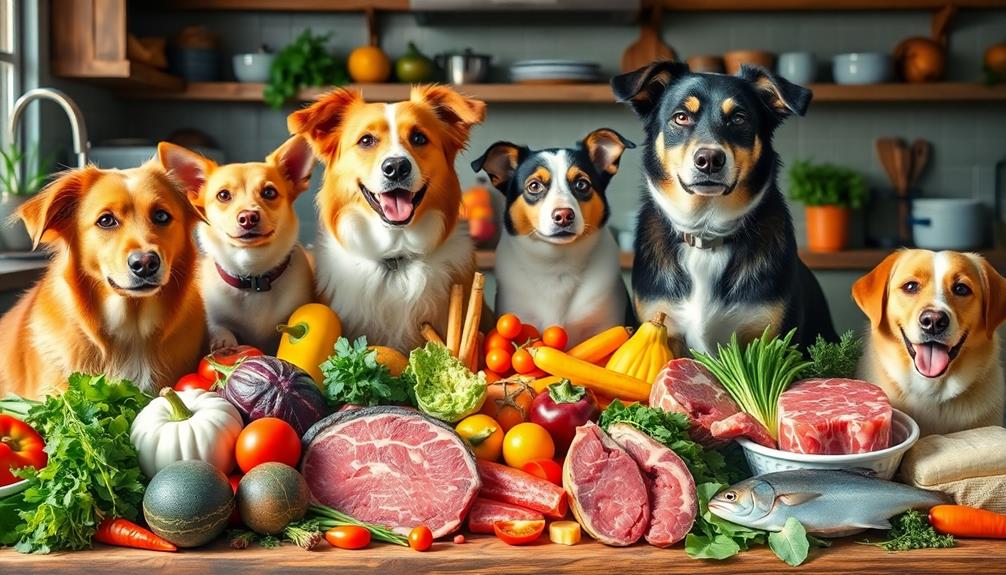A raw food diet can tremendously benefit your senior dog by improving digestion, boosting energy, and promoting a healthier coat. To modify their diet, gradually mix raw food with their regular kibble over 7-10 days, observing for any digestive issues. Incorporate high-quality proteins and omega-3s for muscle maintenance and skin health. While changing, consider adding probiotics to enhance gut health. Understand that consulting your vet is essential for a balanced approach. With the right planning and precautions, such as sourcing safe ingredients and maintaining hygiene, your senior dog can thrive on this nourishing diet. There's more to explore about this topic!
Key Takeaways
- A raw diet can improve senior dogs' digestive health, leading to smaller, firmer stools and enhanced nutrient absorption.
- Gradually transitioning to raw food over 7-10 days helps minimize digestive upset and allows dogs to adjust.
- Incorporating high-quality proteins and omega-3 fatty acids supports muscle maintenance and skin health in aging dogs.
- Regular vet check-ups and monitoring are crucial to ensure a balanced diet and address any nutritional imbalances.
- Fresh fruits and vegetables in a raw diet provide essential vitamins and minerals that promote overall health and vitality.
Benefits of a Raw Diet

When considering a raw diet for your senior dog, the benefits can be quite significant. A raw diet can improve your dog's digestive system, leading to smaller, firmer stools and better nutrient absorption. This enhanced digestion also contributes to a healthier gut flora, supporting overall well-being.
You'll likely notice increased energy levels in your senior dog, allowing them to enjoy a more active lifestyle. This boost in liveliness can improve their quality of life and encourage playfulness.
Additionally, raw diets can aid in weight management, helping your dog maintain a healthy body condition and reducing the risk of obesity-related health issues.
Another advantage is the potential reduction in allergy symptoms. By minimizing processed ingredients, a raw diet can alleviate skin irritations, leading to improved coat condition and overall skin health. This means your furry friend can feel more comfortable in their own skin.
Transitioning to Raw Diet

When shifting your senior dog to a raw diet, it's vital to do so gradually over 7-10 days.
Start by mixing a small amount of raw food with their current kibble and monitor their stool and overall health.
Adding probiotics at the beginning can help support their digestive system and ease the adjustment process.
Gradual Transition Steps
Changing your senior dog to a raw food diet is best done gradually, typically over 7-10 days. Start by mixing small amounts of raw food into your dog's existing kibble. This gradual change helps minimize digestive upset, allowing your senior dog's system to adjust.
Begin with simple proteins like chicken or turkey, and increase the raw food proportion to about 50% before fully committing to a raw diet.
As you make this shift, monitor your senior dog closely for any signs of digestive upset, such as loose stools. If you notice any issues, adjust the raw to kibble ratio accordingly. Remember, every dog is different, and some may need a slower change than others.
Probiotics can help establish healthy bacteria in your dog's gut, easing the adjustment to the new diet. Consider incorporating these beneficial microorganisms before and during the change.
Additionally, consider using food toppers or blended vegetables to enhance the appeal of raw meals, especially if your dog is a picky eater.
With patience and careful monitoring, you can successfully change your senior dog to a raw food diet that supports their health and well-being.
Probiotics for Digestive Health
Probiotics play an essential role in supporting your senior dog's digestive health during the change to a raw food diet. These beneficial bacteria help establish healthy gut flora, which is important for minimizing digestive upset and enhancing nutrient absorption. Before changing to raw food, introducing probiotics can help cleanse the buildup of bad fats and starches from previous diets, particularly significant for aging dogs.
To aid your dog's adjustment to raw, consider high-quality probiotic supplements or fermented foods like kefir and yogurt. Keep an eye on your dog's stool consistency; while loose stools may occur initially, they should stabilize as their digestive system adapts to the new diet. By improving gut health, probiotics enhance overall digestive efficiency, which is essential as senior dogs may experience a decline in digestive function with age.
Here's a quick overview of probiotics and their benefits:
| Probiotic Source | Benefits | Recommended Amount |
|---|---|---|
| Kefir | Boosts gut health | 1-2 tablespoons daily |
| Yogurt | Enhances nutrient absorption | 1-2 tablespoons daily |
| Probiotic Supplements | Supports digestive health | Follow product instructions |
Essential Nutrients for Seniors

A balanced raw diet is fundamental for senior dogs to thrive. This diet should include high-quality proteins from meat and fish sources, which support lean muscle mass and overall health. Incorporating options like best dog food for allergies can also help manage any sensitivities your senior dog may have.
Important fatty acids, particularly Omega-3, play a significant role in maintaining skin and coat health, especially for aging dogs who may be prone to skin issues.
Incorporating raw fruits and vegetables into their meals provides essential vitamins and minerals that enhance immune function and offer antioxidant properties. These nutrients can help combat the effects of aging, keeping your senior dog healthier for longer.
Additionally, including bone content in their diet guarantees a proper balance of calcium and phosphorus, which is necessary for maintaining strong bone health.
Don't forget about probiotics, either! They aid in digestion and improve gut health, which is especially important for senior dogs who may experience digestive issues.
Common Concerns and Solutions

When considering a raw food diet for your senior dog, you might've concerns about bacterial contamination and nutritional imbalances.
It's important to consult with a vet to create a balanced plan that meets your dog's specific health needs.
Additionally, while raw feeding can seem expensive upfront, the long-term health benefits may save you money on vet bills down the line.
Bacterial Contamination Risks
Bacterial contamination poses a significant concern for pet owners considering a raw food diet for their senior dogs. Pathogens like Salmonella and E. coli can affect both your pet and anyone handling the food. By being aware of the risks, you can take steps to guarantee safe raw feeding practices.
Here's a quick reference table for you:
| Concern | Risk Factor | Solution |
|---|---|---|
| Bacterial Contamination | Pathogens like Salmonella and E. coli | Source from reputable suppliers |
| Hygiene Practices | Cross-contamination from surfaces | Sanitize surfaces and wash hands |
| Health Check-ups | Signs of infection or digestive upset | Regular vet visits for monitoring |
| Nutritional Quality | Compromised nutrition due to improper handling | Use high-pressure processed ingredients |
Nutritional Imbalance Issues
Maneuvering the nutritional landscape of a raw food diet for senior dogs can be tricky, as imbalances may arise if meals aren't carefully formulated. Nutritional imbalances can lead to deficiencies in essential vitamins and minerals, which are fundamental for your senior dog's health.
To prevent this, make certain to incorporate a variety of proteins, organs, and bioavailable greens in their diet. Regularly monitoring calcium and phosphorus levels is essential, as excessive phosphorus can harm your senior dog's kidneys. Balancing these minerals guarantees their well-being while on a raw diet.
Additionally, consider using supplements like probiotics and functional foods to address any potential imbalances. These can enhance digestion and improve nutrient absorption, making it easier for your senior dog to thrive.
It's always a good idea to consult with a veterinarian when planning your dog's meals. They can provide personalized guidance to confirm that the raw diet meets your senior dog's specific nutritional needs.
Cost Considerations
Switching your senior dog to a raw food diet can raise questions about costs, but it's important to weigh the long-term benefits against initial expenses. While raw diets may seem pricier than kibble, they can lead to better health, reducing future veterinary bills related to chronic illnesses.
Here's a quick comparison of cost considerations:
| Cost Aspect | Raw Diet |
|---|---|
| Nutritional Value | Higher, fewer fillers |
| Budget Control | Homemade meals can save money |
| Sourcing Ingredients | Local farms often offer lower prices |
| Long-Term Savings | Reduced vet bills from better health |
Additionally, preparing homemade meals allows you to buy in bulk, further controlling your budget. While processed foods may seem cheaper upfront, they often lack quality nutrition and can lead to additional health issues. By gradually adapting to a raw diet and monitoring portion sizes, you can manage costs effectively while ensuring your senior dog receives healthy food that enhances their quality of life. Ultimately, investing in a raw diet can prove to be cost-effective in the long run.
Long-term Health Considerations

When considering a raw food diet for your senior dog, several long-term health factors come into play. Regular health check-ups are essential to monitor your dog's condition and make necessary dietary adjustments based on changes in health status or weight.
A raw dog food diet can positively impact your senior dog's digestive system, but it requires you to stay informed about feeding raw practices to guarantee optimal health. Additionally, it's important to be aware that some common human foods, like grapes are toxic to dogs, and should be avoided entirely. Maintaining a balance of safe and nutritious foods is key to your dog's overall well-being.
Maintaining dental health is another critical aspect; the enhanced chewing from raw food can help prevent dental issues that are common in older dogs. However, it's necessary to use appropriate feeding materials, like ceramic or stainless steel bowls, to guarantee hygiene and safety.
You should also consider the potential for increased food costs over time, as high-quality ingredients for a raw diet can be pricier than processed kibble. Additionally, incorporating probiotics into your dog's diet may further help maintain their digestive health.
Safety Measures for Senior Dogs

Ensuring safety for senior dogs on a raw food diet involves several critical practices that can help mitigate health risks.
First, focus on sourcing high-quality ingredients. Using trusted suppliers is essential to avoid nutritional imbalances that could affect your dog's digestive and immune health. Regular health check-ups are crucial for monitoring your senior dog's condition, allowing you to make timely adjustments to their diet as needed.
Next, maintain proper hygiene when handling raw food. Always sanitize surfaces and wash your hands thoroughly to minimize the risk of bacterial contamination, such as Salmonella. This is especially important for senior dogs, who may have compromised immune systems.
Additionally, don't overlook the significance of oral hygiene. While raw feeding can promote dental health through the chewing action, regular vet visits are necessary to monitor for potential dental issues.
Frequently Asked Questions
Is Raw Diet Good for Senior Dogs?
A raw diet can be beneficial for senior dogs, as it offers high-quality proteins and essential nutrients. You might notice improved digestion, energy levels, and overall health, helping your furry friend enjoy a better quality of life.
What Is the Best Raw Protein for Senior Dogs?
When choosing the best raw protein for your senior dog, consider high-quality options like chicken, turkey, fish, and organ meats. These choices support digestion, muscle maintenance, and overall health, ensuring your furry friend thrives.
How Should a Dog's Diet Change When They Become a Senior?
As your dog ages, adapt their diet to guarantee easier digestion and balanced nutrition. Focus on fresh foods, higher-quality proteins, and healthy fats to foster energy and support their overall well-being during their golden years.
What Is the Healthiest Meat for Senior Dogs?
When choosing the healthiest meat for your senior dog, lean meats like chicken and turkey, fatty fish like salmon, and nutrient-rich organ meats are excellent options. These choices support overall health and energy levels effectively.
Conclusion
Switching your senior dog to a raw food diet may seem intimidating, but the benefits can be remarkable. You might worry about the safety of raw food, but with proper preparation and sourcing, you can guarantee a nutritious and safe meal plan. Imagine your furry friend thriving with more energy, healthier skin, and improved digestion. Embracing this dietary change could lead to a happier, more vibrant life for your beloved companion. It's worth the effort!










